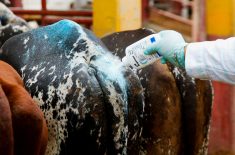Chicago Mercantile Exchange live cattle futures closed lower on Wednesday as wholesale beef markets began to ease from record peaks and on some outlooks for lower cash cattle markets late this week, traders and analysts said.
“They’re expecting weakness in cash cattle markets; there is seasonal weakness and there should be a lot of cattle coming to market,” said Jim Clarkson, a broker for A+A Trading Inc.
CME live cattle for June delivery were down 0.7 cent per pound at 120.250 cents (all figures US$). August delivery cattle were down 0.85, at 119.275.
Read Also

U.S. grains: Soy futures post biggest monthly gain in nearly five years on China trade optimism
U.S. soybean futures climbed to a 15-month high and posted their biggest monthly gain in nearly five years on Friday following a rally fueled by the prospect of revived exports to China.
The U.S. Department of Agriculture’s boxed beef report early on Wednesday showed choice wholesale carcasses down 89 cents per hundredweight (cwt) at $204.40.
There were no cash bids or asking prices reported by feedlot sources on Wednesday and cash cattle last week moved at $124-$125/cwt.
Some analysts were skeptical that weakness in the cash market would develop this week, which helped keep cattle futures from falling further.
The number of cattle up for sale is roughly steady with last week, which may support cash prices, an analyst said.
“I think everybody is looking for cash to come down but I don’t see that happening because futures already are at a big discount to cash,” said Jack Salzsieder, a broker for K+S Financials.
Estimated margins for U.S. beef packing companies on Wednesday were a positive $43.35 per head, down from $51.90 on Tuesday and below the $68.35 per head level a week ago, according to Denver-based livestock marketing advisory service HedgersEdge.com LLC.
Bullish-minded traders were skeptical that cattle futures would fall much further, citing the still-strong demand for retail beef despite historically high prices.
“I don’t see any reason for producers to be hedging or selling at these levels,” Salzsieder said.
“And with June futures around 120 and wholesale beef over 200, that tells me beef is moving, so I can’t get that bearish about futures,” Salzsieder said.
Feeder cattle futures also eased on spillover pressure from the decline in live cattle and on tight stocks of corn in the United States that is expected to keep feeding costs high.
CME feeder cattle for August delivery were down 0.975 cent/lb. at 144.6 cents/lb., and for September they were down 0.7, at 146.85 cents.
Hog industry “basks”
Lean hog futures closed mixed with deferred contracts easier on bull spreading but spot June held firm on strong cash hog markets and ongoing brisk demand for retail pork.
“Cash hogs are still very firm,” Clarkson said.
Cash hog markets in the U.S. Midwest on Wednesday were steady but the supply of hogs was tight and packers were showing some need for the tight supply.
“Everything fundamental seems to have a bit more of a positive tone as the industry basks in the warm glow of the proposed Smithfield sale,” a cash dealer said.
However, the head of the U.S. Senate Agriculture Committee on Wednesday said she was concerned about the food safety implications posed by the proposed purchase of pork producer Smithfield Foods by Shuanghui International, a Chinese meat products company.
Estimated margins for U.S. pork packing companies on Wednesday were a negative $3.25 per head, up from a minus $6.55 on Tuesday but below the negative $2.75 per head level a week ago, according to HedgersEdge.
CME lean hogs for June delivery were up 0.125 cent/lb. at 96.65 cents; July hogs were down 0.175 cent/lb. at 94.575 cents.
— Sam Nelson reports on ag commodity futures for Reuters from Chicago. Additional reporting for Reuters by Alyce Hinton in Chicago.











